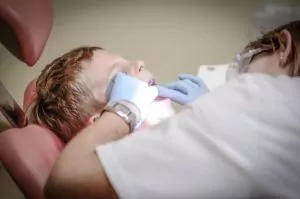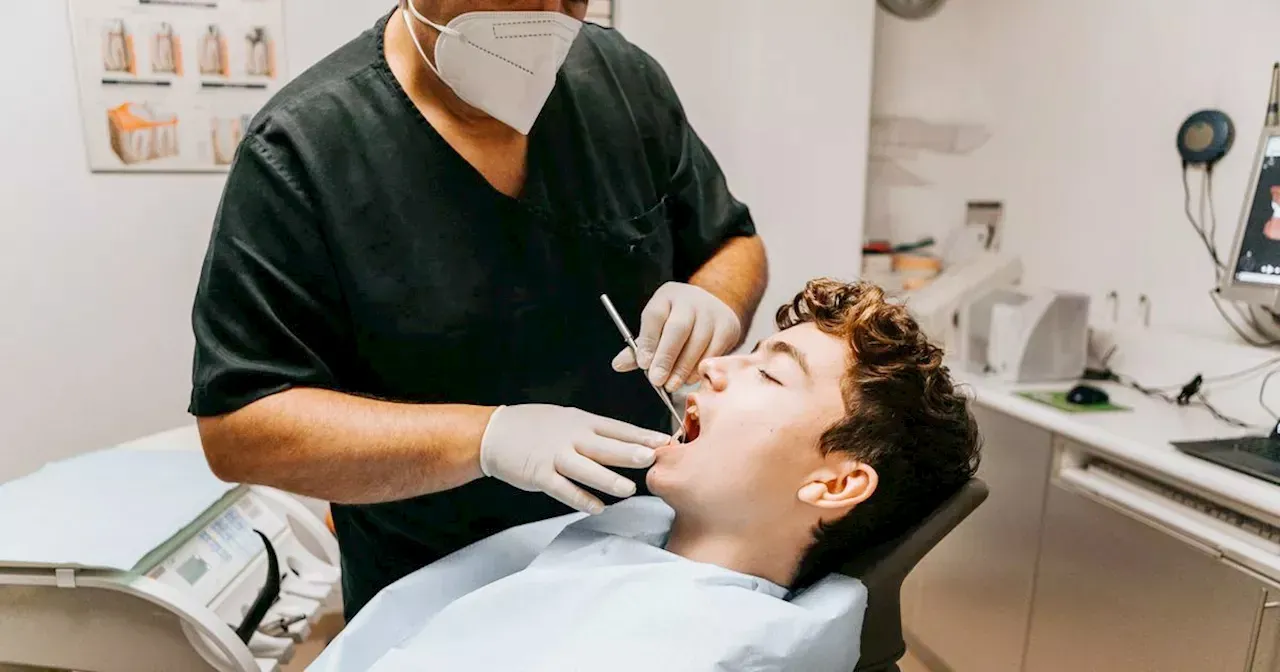 A cavity is an infection that weakens tooth enamel, i.e. the hard, protective outer layer of your teeth. When bacteria is not properly removed via brushing and flossing, it eats away at tooth enamel. This bacteria usually comes from foods that contain carbohydrates and become trapped in the teeth. The result: cavities develop. If cavities go unaddressed, they will grow – eventually causing decay that destroys teeth.
A cavity is an infection that weakens tooth enamel, i.e. the hard, protective outer layer of your teeth. When bacteria is not properly removed via brushing and flossing, it eats away at tooth enamel. This bacteria usually comes from foods that contain carbohydrates and become trapped in the teeth. The result: cavities develop. If cavities go unaddressed, they will grow – eventually causing decay that destroys teeth.
A Look Back in History
Cavities, also referred to as dental caries, have caused tooth pain for millions of years. Fossils from the Australopithecus species reveal some of the earliest dental caries from 1.1 million to 4.4 million years ago. Paleolithic and Mesolithic skulls also show signs of cavities. The Paleolithic period took place roughly 3.3 million years ago, and the Mesolithic period began around 8,000 BC.
History of Tooth Decay
Two of the leading factors of increased dental caries were the consumption of plant-based foods containing carbohydrates and rice cultivation. This led to the development of the first cavity treatments in Pakistan between 7,000 BC and 5,500 BC. At this time, simple dental drills were used to treat cavities. Text from the Sargonid dynasty of Assyria (which lasted from 668 BC to 626 BC) revealed that tooth inflammation was cured via tooth extraction. Ancient Egyptians, Greeks and Romans also used a broad range of cavity treatments.
In the 11th century, the appearance of sugar cane led to an increase in the number of reported cavities. Top treatments for dental caries at this time included charms and herbal remedies.
Meanwhile, the Age of Enlightenment proved to be a critical period for the advancement of cavity treatments. French physician Pierre Fauchard, often considered the father of modern dentistry, was one of the first people to cite sugar as a possible cause of cavities.
In the 1890s, W.D. Miller, the world’s first oral microbiologist, said he believed bacteria in the mouth could dissolve tooth structures. Miller and dental pioneers G.V. Black and J.L. Williams researched plaque and investigated the causes of dental caries.
In 1921, scientist Fernando E. Rodriguez Vargas discovered several strains of lactobacilli bacteria linked to dental caries. Vargas’ discovery was followed by researcher Killian Clarke’s suggestion in 1924 that the bacterial strain Streptococcus mutans was responsible for cavities. Hamster studies performed by R.J. Fitzgerald and Paul Keyes in the 1950s ultimately showed a direct correlation between bacteria and cavities.
Cavities currently represent the most prevalent chronic disease in both children and adults, according to the National Institute of Dental and Craniofacial Research. However, cavities are preventable, and dental treatments are available to address dental caries and other oral health issues.
How to Prevent and Treat Cavities
To help prevent cavities, you can:
• Maintain a healthy diet. Sugary food and drink feeds bacteria in the mouth that can cause cavities. Enjoy sugary foods and drinks in moderation to limit the risk of dental caries.
• Use a fluoride toothpaste. Fluoridated toothpaste helps to reduce the breakdown of enamel and mineral loss in the teeth. By brushing the teeth regularly with fluoridated toothpaste, an individual can enhance his or her tooth enamel and prevent tooth decay.
• Floss the teeth daily. Food particles sometimes accumulate in the spaces between the teeth and can be difficult to remove with a toothbrush alone. Daily flossing allows a person to eliminate tough-to-reach food particles in the teeth, as well as develop healthy gums and teeth.
• Replace your toothbrush at least every three months. Toothbrush bristles wear down with extended use. To get the best results when brushing the teeth, replace your toothbrush at least every three months.
• Go to the dentist at least twice a year. Regular dental appointments are paramount. They help you identify the initial warning signs of cavities and treat dental caries and other oral health issues before they get out of hand.
Options for Cavity Treatment at TSD
If you suffer from a consistent toothache or tooth sensitivity, you may be dealing with one or more cavities. It is important to seek out a dentist immediately to identify and address the problem.
Dental fillings and crowns are among the most common cavity treatments. If a tooth is damaged by decay, a dentist may recommend a filling. If a large portion of a tooth has been severely damaged or virtually destroyed by decay, a dentist may recommend a crown.
A dental filling is frequently used to remove decayed material from a tooth, as well as to repair broken or cracked teeth. During a dental filling treatment, a dentist removes decayed tooth material, cleans the affected area of the mouth and fills the area. The dental filling material is usually determined by the severity of tooth decay and other factors. A dentist may use gold, porcelain, composite resin or another type of dental filling.
A dental crown helps restore a tooth damaged by decay to its previous size, shape and function. A crown may consist of metal alloy, ceramic, porcelain or other materials used to resemble the color of a patient’s teeth. During a dental crown procedure, a dentist removes decayed material from the affected tooth, makes an impression of the treatment area and fits the crown accordingly.
Even if you receive a dental filling or crown, there is no guarantee that you will not get cavities going forward. That’s why it is essential to have a plan in place to prevent dental caries. Fortunately, The Super Dentists of San Diego help you and your children prevent and treat cavities and other oral health problems.
Now, let’s take a closer look at the history of cavities.
Fossils Reveal First Cavities
Fossils dating back 4.4 million years revealed some of the earliest cavities. Paleolithic skulls dating back roughly 3.3 million years and Mesolithic skulls from around 8,000 BC also showed signs of cavities.
Introducing the First Cavity Treatments
Simple dental drills were used to treat cavities in Pakistan between 7,000 BC and 5,500 BC. The Sargonid dynasty of Assyria (which lasted from 668 BC to 626 BC) used tooth extraction to treat cavities. Ancient Egyptians, Greeks and Romans developed cavity treatments, too.
History of Cavity Treatment: New Foods Lead to Innovation
The consumption of plant-based foods containing carbohydrates, rice cultivation and the first appearance of sugar cane led to an increase in cavities. People cultivated the use of charms, herbal remedies and other innovative cavity treatments.
French Physician Identifies Possible Cause of Cavities
In the late 17th century, French physician Pierre Fauchard cited sugar as a potential cause of cavities. He also introduced dental fillings to treat cavities.
Researchers Develop an Etiology of Cavities
In the 1890s, W.D. Miller, the world’s first oral microbiologist, cited bacteria in the mouth as a primary cause of cavities. He worked alongside researchers G.V. Black and J.L. Williams to study plaque and craft an etiology of cavities.
Bacteria Linked to Cavities
In the 1920s, researchers Fernando E. Rodriguez Vargas and Killian Clark found links between different bacterial strains and cavities. In the 1950s, hamster studies performed by R.J. Fitzgerald and Paul Keyes showed a direct link between bacteria and cavities.
Cavities Today: Here’s What You Need to Know
According to the National Institute of Dental and Craniofacial Research, cavities are the most prevalent chronic disease in the United States. They affect men, women and children and often go untreated – even though cavities are preventable.
The Super Dentists can treat your child’s cavities and help prevent them from getting new ones. We have 5 locations in San Diego County. Book an appointment online at TheSuperDentists.com, via text at 1.844.765.1234 or call 1(855) GO SUPER.
Book an Appointment with The Super Dentists Today
Cavities have been persistent problems for men, women and children for millennia. Yet cavities often go untreated. And the longer cavities persist inside a person’s mouth, the more likely that it will cause long-lasting tooth decay.
The Super Dentists prioritizes patient care. When it comes to cavities, The Super Dentists want patients to receive immediate treatment and find ways to prevent dental caries from becoming long-term problems. With our patient-centric approach to dental care, we help parents and children establish good oral health habits. That way, our patients can enjoy beautiful, healthy teeth and picture-perfect smiles.
Dealing with cavities or other oral health issues? The Super Dentists can help. To schedule an appointment, please contact us today on our website or at 1 (855) GO SUPER.










